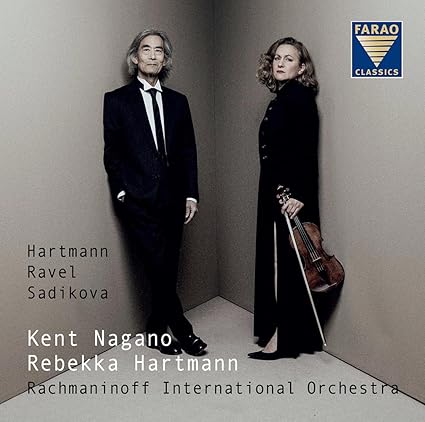

Karl Amadeus Hartmann (1905-1963): Concerto funebre - for Violin and String Orchestra Maurice Ravel (1875-1937): Tzigane - Rhapsody for Violin and Orchestra Aziza Sadikova (b. 1978): Stradivari - for Violin and Orchestra (2020)
If I may permit myself to start this review with a point of contention: Here we go again - using social inclusion to inflict hideous music (if it can even be classified as music) on the listener. In the booklet notes musician and journalist Rita Argauer writes: "The three works each offer a very individual artistic view of the many different cultural currents of Europe. They show us a musical treatment and blending that can only take place when the ideological fronts soften, allowing an attitude of openness, and above all the affection that accompanies such a point of view. How comforting it is when such an experience of reality is conveyed through art. And how forward-looking, both artistically and socially!" Pardon me if I believe this to be total hogwash. It would be like an art collector hanging a painting by Johannes Vermeer and one by Jackson Pollock next to each other on the same wall and trying to convince everyone they complement each other.
Now let's focus on the main work in this collection of pieces for violin and orchestra. The Concerto funebre by Karl Amadeus Hartmann was composed in 1939 at the onset of World War II, as a reflection on and a reaction to the turbulent and nefarious changes sweeping over Europe at the time. Not as blatantly obvious as say Shostakovich's "war" symphonies, but it still paints a rather bleak and dark picture of the times.
As in his Sinfonia Tragica, one of my favorite 20th century symphonic works, the tone is often seething with fear, anguish, and a drive to expose the iniquity at hand. The sense of dread in this Concerto's short opening Introduction (Largo) is palpable, like a dense fog slithering in under the door. The dark colors that violinist Rebekka Hartmann projects within the following Adagio movement are like cries for help. Plaintive, suppliant as in a personal prayer questing for a resolution. A stirring moment within Karl Amadeus Hartmann's output convincingly expressed by both soloist and conductor.
A chaotic Allegro di molto ensues, rhythmically aggressive passages cut short by discursive solo musings. The tragic final Choral movement, like a quiet resignation, melts away until a loud and defiant final chord boasts of a brighter tomorrow.
This is a highly evocative and powerfully expressive work by Hartmann, that speaks volumes about its time and place in music, which is why I don't quite understand the inclusion, or parallel if there is any, with the work Stradivari by Uzbek composer Aziza Sadikova. It's meant to be a reflection on the famous Italian violin maker and the sound of his violins, apparently quoting music from the Italian Baroque which is completely undecipherable from all the other noises within the music. Most of what I heard throughout was clusters of loud brass instruments baaing like a flock of sheep or goats.
Sorry Rebekka Hartmann, I understand that you commissioned this 2020 work, but surely something else, anything else, more in keeping with Hartmann and Ravel would have been a better choice. Inclusion is not the solution, but merit and distinction are.
Jean-Yves Duperron - June 2025 Concerto funebre - Introduction